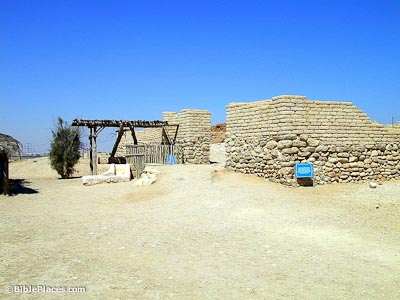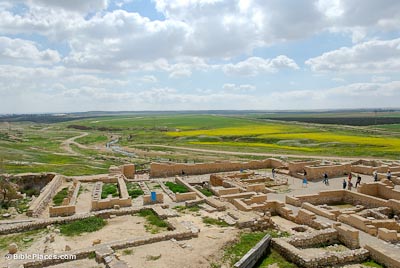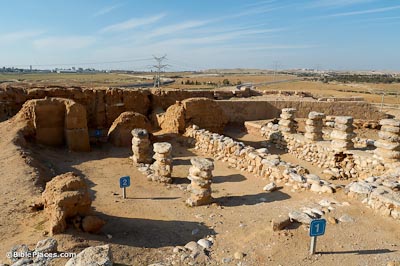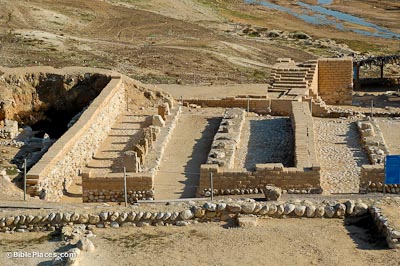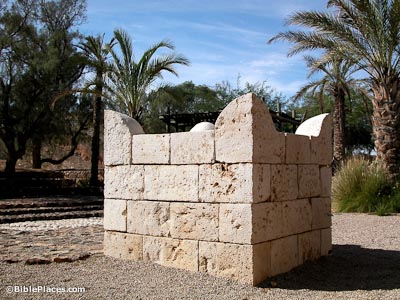Near the outer gate of the city are a well and a tamarisk tree. Both are later than the time of the patriarchs, but they remind one of the well Abraham dug and the tree he planted (Gen 21). The tamarisk tree is well suited to life in the Negev with its deep root system and its ability to survive on brackish water. It secretes salt on its leaves and drips water in the morning.
Beersheba
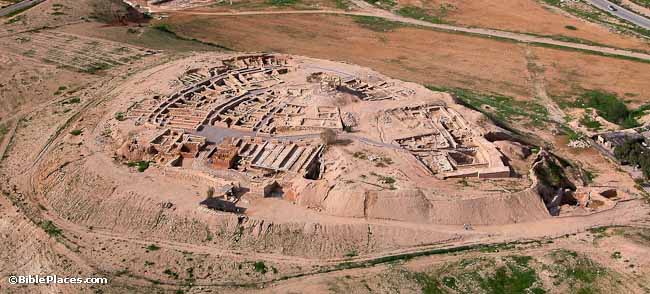
Stratum II
Excavated by Y. Aharoni from 1969 to 1975, broad areas of Stratum II of Tell Sheba were exposed.
Reconstruction work began in 1990 and has concentrated on rebuilding the city as it was in the latter part of the 8th century, the time of King Hezekiah.
Four-Room House
Better known as an Israelite pillared building, this typical structure has been found around the country throughout the Iron Age (1200–600 BC).
Subdivided by pillars into smaller rooms, these houses were often built against the city wall, with the house’s back wall forming a portion of the city’s casemate wall.
Stables or Storehouses?
Three tripartite pillared buildings were revealed in the excavations. The archaeologists believe that these are storehouses in part because of the large number of vessels found inside.
Other scholars regard this building design as characteristic of stables and overwhelming evidence suggests this is a more accurate identification.
Four-Horned Altar
Sandstone blocks integrated into the walls of the storehouses were originally part of a four-horned altar. Three of the sandstone blocks preserved the shape of large horns typical of four-horned altars, while a fourth showed evidence that the horn had been broken off. Another of the stones bore the image of a deeply incised serpent.

Download all of our Negev and the Wilderness photos!
$34.00 $49.99 FREE SHIPPING
Related Websites
For a related site, see Hebron. For a related Bible chapter, see Genesis 22. For historical images illustrating Abraham’s sojourn, see Life in the Holy Land.
Beersheba (See The Holy Land) This page is an approachable and well-illustrated introduction to Beersheba’s biblical significance and archaeological remains.
Tel Be’er Sheva, City of the Patriarchs (Bible History Daily) Accompanied by numerous helpful photographs, this page gives an excellent introduction to Beersheba, including both biblical references and tangible archaeological remains.
Ancient City of Beersheba (Jewish Virtual Library) A helpful discussion of the archaeological data found at the site.
Beersheba (Jewish Virtual Library) Blends ancient and modern history, recognizing the common thread: “the untamed wilderness.”
The Archeology of Tel Be’er Sheva and the Stories It Tells (chabad.org) Along with a really excellent aerial photograph, this article gives the history of the site, including a focus on how it figures in the prophecies of Amos.
Uncovering the Bible’s Buried Cities: Beersheba (Armstrong Institute of Biblical Archaeology) A seven-minute video and a number of historic illustrations set this historic overview apart from the rest.
Beersheba: The City Where All Three Patriarchs Lived (The Israel Bible) This article is unique in taking a very Hebrew approach to the site, including a discussion of the name’s origin; in addition to this, it includes a solid paragraph about the site’s importance in World War I, including a four-minute video commemorating the centennial of that battle (including an address from Prime Minister Netanyahu and historic video footage!).
Tel Beer Sheva National Park (Israel Nature & Parks Authority) A good introduction to various aspects of the site. Also offers visitor info.
Tel Sheva (Israel Antiquities Authority) A summary report of excavations done in 2013. It includes several photos, as well as a plan of the excavated area.
